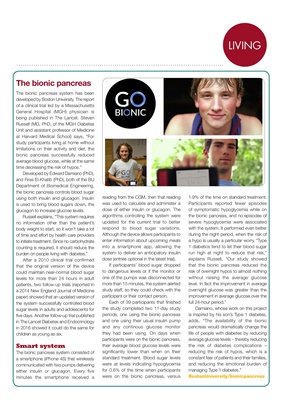
KITLIVING
The bionic pancreas system has been
developed by Boston University. The report
of a clinical trial led by a Massachusetts
General Hospital (MGH) physician is
being published in The Lancet. Steven
Russell (MD, PhD, of the MGH Diabetes
Unit and assistant professor of Medicine
at Harvard Medical School) says, "For
study participants living at home without
limitations on their activity and diet, the
bionic pancreas successfully reduced
average blood glucose, while at the same
time decreasing the risk of hypos."
Developed by Edward Damiano (PhD),
and Firas El-Khatib (PhD), both of the BU
Department of Biomedical Engineering,
the bionic pancreas controls blood sugar
using both insulin and glucagon. Insulin
is used to bring blood sugars down, the
glucagon to increase glucose levels.
Russell explains, "This system requires
no information other than the patient's
body weight to start, so it won't take a lot
of time and effort by health care providers
to initiate treatment. Since no carbohydrate
counting is required, it should reduce the
burden on people living with diabetes."
After a 2010 clinical trial confirmed
that the original version of the device
could maintain near-normal blood sugar
levels for more than 24 hours in adult
patients, two follow-up trials (reported in
a 2014 New England Journal of Medicine
paper) showed that an updated version of
the system successfully controlled blood
sugar levels in adults and adolescents for
five days. Another follow-up trial published
in The Lancet Diabetes and Endocrinology
in 2016 showed it could do the same for
children as young as six.
Smart system
The bionic pancreas system consisted of
a smartphone (iPhone 4S) that wirelessly
communicated with two pumps delivering
either insulin or glucagon. Every five
minutes the smartphone received a
reading from the CGM, then that reading
was used to calculate and administer a
dose of either insulin or glucagon. The
algorithms controlling the system were
updated for the current trial to better
respond to blood sugar variations.
Although the device allows participants to
enter information about upcoming meals
into a smartphone app, allowing the
system to deliver an anticipatory insulin
dose (entries optional in the latest trial).
If participants' blood sugar dropped
to dangerous levels or if the monitor or
one of the pumps was disconnected for
more than 15 minutes, the system alerted
study staff, so they could check with the
participant or their contact person.
Each of 39 participants that finished
the study completed two 11-day study
periods, one using the bionic pancreas
and one using their usual insulin pump
and any continous glucose monitor
they had been using. On days when
participants were on the bionic pancreas,
their average blood glucose levels were
significantly lower than when on their
standard treatment. Blood sugar levels
were at levels indicating hypoglycemia
for 0.6% of the time when participants
were on the bionic pancreas, versus
1.9% of the time on standard treatment.
Participants reported fewer episodes
of symptomatic hypoglycemia while on
the bionic pancreas, and no episodes of
severe hypoglycemia were associated
with the system. It performed even better
during the night period, when the risk of
a hypo is usually a particular worry. "Type
1 diabetics tend to let their blood sugar
run high at night to reduce that risk,"
explains Russell, "Our study showed
that the bionic pancreas reduced the
risk of overnight hypos to almost nothing
without raising the average glucose
level. In fact the improvement in average
overnight glucose was greater than the
improvement in average glucose over the
full 24-hour period."
Damiano, whose work on this project
is inspired by his son's Type 1 diabetes,
adds, "The availability of the bionic
pancreas would dramatically change the
life of people with diabetes by reducing
average glucose levels - thereby reducing
the risk of diabetes complications -
reducing the risk of hypos, which is a
constant fear of patients and their families,
and reducing the emotional burden of
managing Type 1 diabetes."
The bionic pancreas